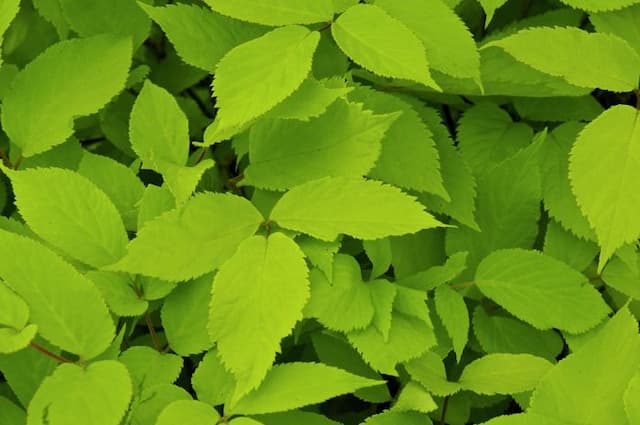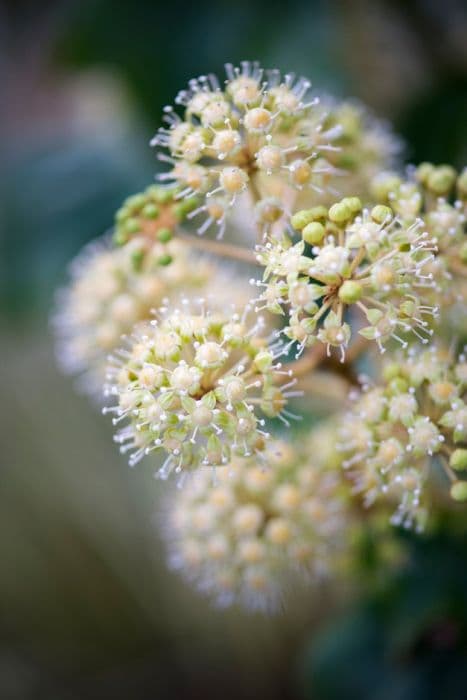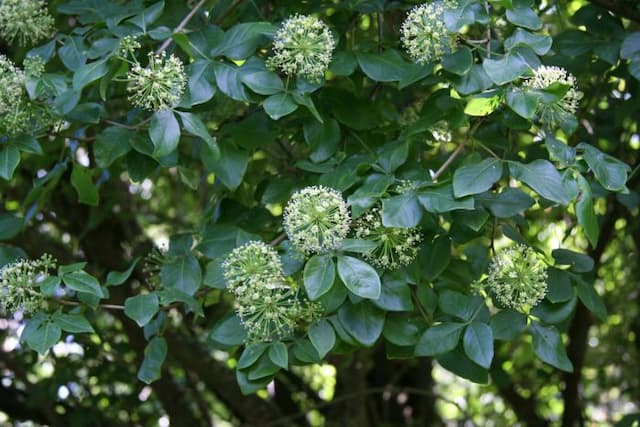Persian Ivy Hedera colchica 'Dentata'

ABOUT
Hedera colchica 'Dentata', commonly known as Persian Ivy, is a vigorous climbing plant known for its lush foliage. The leaves of Persian Ivy are one of its most distinctive features. They are large, with a heart-like base and a broad, rounded shape. The leaf edges have a unique appearance thanks to a light serration that resembles gentle waves rather than the sharp teeth found in some other varieties. This gives the 'Dentata' variety a somewhat softer look. The color of the leaves is a deep green, which can appear almost glossy and highlights the lighter veins that run through them. The leaves maintain their vibrant color throughout the year, making Persian Ivy an excellent choice for adding year-round greenery to a garden or as an indoor houseplant. Persian Ivy can produce small flowers, which are generally not showy and are often unnoticed against the backdrop of the dense foliage. These flowers may give way to small, dark berries, which are usually hidden within the leaves and are not prominent features of the plant. Overall, Persian Ivy 'Dentata' is prized for its ornamental leaves, which bring a touch of evergreen elegance to landscapes or indoor settings.
About this plant
 Names
NamesFamily
Araliaceae
Synonyms
Persian Ivy, Colchis Ivy
Common names
Hedera colchica 'Dentata'
 Toxicity
ToxicityTo humans
Persian Ivy, the common name for Hedera colchica 'Dentata', is considered toxic if ingested. All parts of the Persian Ivy contain saponins, and can cause gastrointestinal symptoms such as vomiting, diarrhea, and abdominal pain. In addition, contact with the sap can cause skin irritation or allergic reactions in some individuals. The ingestion of large quantities can be particularly harmful and may result in severe symptoms that could require medical attention.
To pets
Persian Ivy, known commonly as Persian Ivy, is toxic to pets if ingested. Saponins present in all parts of the plant can cause vomiting, diarrhea, hyper-salivation, and abdominal pain in pets. In rare cases, ingestion can lead to more severe symptoms such as difficulty breathing, convulsions, or even coma if consumed in large amounts. Immediate veterinary care should be sought if a pet ingests any part of this plant.
 Characteristics
CharacteristicsLife cycle
Perennials
Foliage type
Evergreen
Color of leaves
Green
Height
10 feet (3 meters)
Spread
10 feet (3 meters)
Plant type
Climber
Hardiness zones
6
Native area
Caucasus
Benefits
 General Benefits
General Benefits- Ornamental Appeal - Hedera colchica 'Dentata', commonly known as Persian ivy, features attractive, large, and glossy leaves that provide a lush green backdrop in gardens and landscapes.
- Groundcover - Persian ivy is excellent for covering the ground, it helps in preventing soil erosion by stabilizing the soil with its root system.
- Low Maintenance - Once established, Persian ivy requires minimal care, making it a convenient choice for gardeners of all experience levels.
- Shade Tolerance - The plant can thrive in shady areas where other plants might struggle to grow, making it ideal for filling in dark corners of the garden.
- Climbing and Trailing Abilities - It can climb walls and structures, offering vertical greenery that can enhance the aesthetic of buildings and garden features.
- Drought Tolerance - Persian ivy can tolerate periods of dryness once it is well-established, reducing the need for frequent watering.
- Winter Interest - As an evergreen, Persian ivy provides color and texture in the garden even during the cold winter months when many other plants have died back.
- Variability - It offers variability in landscaping with the possibility of creating different textures and layers due to its vigorous growth habits.
- Wildlife Habitat - The dense foliage can serve as shelter for birds and beneficial insects, contributing to local biodiversity.
 Medical Properties
Medical Properties- Anti-inflammatory: Has been traditionally used to reduce inflammation.
- Expectorant: Sometimes used in folk medicine to help clear mucus from the respiratory tract.
- Antimicrobial: Contains compounds that might have antimicrobial effects.
- Analgesic: Used in some traditional medicine systems for its pain-relieving effects.
- Antispasmodic: Believed to help relieve spasms or cramps in some traditional practices.
 Air-purifying Qualities
Air-purifying QualitiesThis plant is not specifically known for air purifying qualities.
 Other Uses
Other Uses- Persian ivy can be used as a natural pest deterrent when planted around the perimeter of a garden, as some pests dislike its texture and strong fragrance.
- The plant's dense foliage can provide a protective shelter for small birds and beneficial insects within a garden ecosystem.
- Due to its evergreen nature, Persian ivy can be used in floral arrangements for winter decorations that require long-lasting greenery.
- The vines of Persian ivy can be trained to grow on trellises or pergolas, creating living green walls that can enhance privacy in urban gardens.
- Its large leaves can be used in crafts, such as leaf imprinting on clay or concrete, to create natural, botanical designs.
- The interwoven structure of Persian ivy can stabilize soil on slopes or embankments, helping to prevent erosion in landscaped areas.
- When allowed to grow on the ground, it can serve as a living mulch, suppressing weed growth and retaining soil moisture.
- In landscape photography, Persian ivy can be used as a visual tool to lead the eye or frame a scene naturally.
- The variety of leaf shapes and sizes in Persian ivy can be an interesting subject for botanical illustration or plant morphology studies.
- When Persian ivy is grown indoors, it can be used in terrariums or fairy gardens for a lush, miniature landscape effect.
Interesting Facts
 Feng Shui
Feng ShuiThe Persian Ivy is not used in Feng Shui practice.
 Zodiac Sign Compitability
Zodiac Sign CompitabilityThe Persian Ivy is not used in astrology practice.
 Plant Symbolism
Plant Symbolism- Eternal Life - Similar to other ivies, the Hedera colchica 'Dentata', also known as Persian Ivy, represents eternal life due to its evergreen nature and its ability to thrive in various conditions.
- Fidelity and Friendship - Persian Ivy, through its clinging growth habit, symbolizes strong relationships, loyalty, and attachment, making it a metaphor for steadfastness in love and friendship.
- Protection - The plant has been thought to ward off evil spirits; hence, it symbolizes protection and is often planted near homes for this purpose.
- Survival and Resilience - Due to its hardiness and the way it can grow and prosper even in challenging environments, Persian Ivy signifies the ability to endure and overcome difficulties.
 Water
WaterPersian ivy should be watered when the top inch of soil feels dry to the touch. Generally, this could mean watering approximately once a week, but it is important to adjust based on the humidity and temperature of the environment. Use lukewarm water, and apply it directly to the soil, avoiding the leaves to prevent fungal diseases. Persian ivy planted in containers may require more frequent watering, potentially several times a week during hot, dry periods. Aim to provide enough water to moisten the soil thoroughly, which could be around a quart for small pots or up to a couple of gallons for large containers or in-ground plants, but be careful not to overwater as this plant is sensitive to waterlogged conditions.
 Light
LightPersian ivy thrives in partial to full shade. The ideal location for this plant is a spot where it receives filtered light or morning sun, followed by shade for the rest of the day. Too much direct sunlight, especially during the hot afternoon hours, can scorch the leaves and cause fading of the foliage. A north-facing or east-facing spot that provides consistent, dappled light is optimal for this ivy variety.
 Temperature
TemperaturePersian ivy prefers a temperature range between 50 to 80 degrees Fahrenheit for optimal growth. It can survive minimum temperatures down to 10 degrees Fahrenheit, making it a hardy plant for outdoor growth in many climates. Ideally, keeping the plant in temperatures that don't exceed 80 degrees Fahrenheit will help prevent heat stress. However, it will tolerate a range of conditions as long as it is not subjected to prolonged periods of high heat or freezing temperatures.
 Pruning
PruningPruning Persian ivy helps to maintain its shape, encourage bushier growth, and remove any dead or damaged foliage. It is best to prune in the late winter or early spring before new growth starts. Trimming can be done as often as needed to control the size of the plant or to keep pathways clear. Use clean, sharp shears to make precise cuts, and try to prune back to just above a leaf to encourage branching.
 Cleaning
CleaningAs needed
 Soil
SoilThe Persian Ivy requires well-draining soil with a pH that's slightly acidic to neutral, ideally between 6.0 and 7.5. For the best soil mix, combine two parts peat or coir, one part perlite or sand, and one part garden soil or loam. This combination promotes healthy root growth and adequate moisture retention without becoming waterlogged.
 Repotting
RepottingPersian Ivy should be repotted every two to three years to prevent it from becoming root-bound and to replenish the nutrients in the soil. However, mature plants that are thriving may not require as frequent repotting and can be refreshed with new topsoil instead.
 Humidity & Misting
Humidity & MistingPersian Ivy thrives in moderate to high humidity levels, ideally between 40% and 70%. To maintain optimal humidity, ensure good air circulation and consider using a humidifier or placing the plant on a water-filled pebble tray to increase ambient moisture.
 Suitable locations
Suitable locationsIndoor
Place Persian Ivy in a well-lit spot, away from direct sun.
Outdoor
Plant it in partial to full shade and water when soil is dry.
Hardiness zone
6-9 USDA.
 Life cycle
Life cycleThe Persian ivy (Hedera colchica 'Dentata') begins its life cycle as a dormant seed, which upon favorable conditions of moisture and temperature, germinates to produce a seedling with juvenile leaves that are usually lobed. As the plant grows, it enters into a vegetative stage characterized by rapid growth of trailing or climbing stems and larger, heart-shaped adult leaves that are leathery and glossy. During this phase, Persian ivy can produce adventitious roots at its nodes that help it to attach to surfaces and absorb nutrients. After several years, when it reaches maturity, it may develop umbels of small, greenish-yellow flowers in late summer to fall, provided it is grown under suitable conditions and has reached a certain stage of maturity. Successfully pollinated flowers will produce blue-black berries, which are often dispersed by birds, allowing the plant to propagate. The Persian ivy can then continue its life cycle by dropping seeds for germination, while the parent plant can live for many years, persisting in its mature state with seasonal cycles of growth, flowering, and fruiting.
 Propogation
PropogationPropogation time
Spring-Early Summer
The Persian Ivy, Hedera colchica 'Dentata', is most commonly propagated through semi-hardwood cuttings. The ideal time for taking cuttings is in summer, when the new growth has matured slightly. To propagate, one would cut a length of stem around 4 to 6 inches (10 to 15 centimeters), making sure to include several leaf nodes. The lower leaves are removed, and the cutting base is often dipped in rooting hormone to encourage root growth. The prepared cutting is then inserted into a well-draining soil mix, taking care not to bury the remaining leaves. It is essential to keep the soil moist but not soggy and to provide a warm environment with indirect light. Roots typically develop in several weeks, after which the new ivy plant can eventually be transplanted outdoors.









